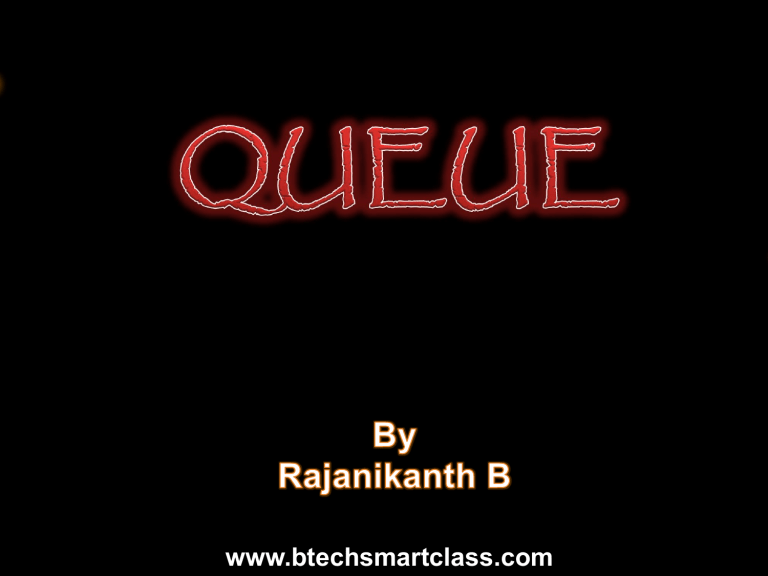
www.btechsmartclass.com
Introduction
Queue is a linear Data Structure in which the
operations are performed based on FIFO (First In
First Out) principle.
In a Queue always the Insertion operation is done at
“rear” and Deletion operation is done at “front”.
In a Queue sequence of elements entered into the
queue is same as the sequence of elements leave
the queue.
Queue
Definition
Fields
• Queue is a linear Data Structure in which the operations
are performed based on FIFO (First In First Out) principle.
• rear – used to store the position of insertion
• front – used to store the position of deletion
• size – used to store the size of the queue
• element – used to store the value to be inserted
• enQueue(element) – to insert into queue
• deQueue( ) – to delete from queue
Functions • display( ) – to display all elements in queue
Condition
• Rear >= size – Queue is full
• Front == rear – Queue is empty
#define size 10
void main()
{
int Q[size], front = -1, rear = -1,op,element;
void enQueue(int);
void deQueue();
void display();
printf(“Select your option: ”);
printf(“1: Insert\n2: Delete\n3: Display\n”);
scanf(“%d”,&op);
switch(op)
{
case 1: printf(“Enter element to be insert: ”);
scanf(“%d”,&element);
enQueue(element);
break;
case 2: deQueue();
break;
case 3: display();
break;
}
}
When the compiler executes above code it allocates memory as
follows….
0
1
2
3
4
5
.
.
.
SIZE-1
Q
f = r = -1
f = front
r = rear
Queue is EMPTY
Insertion
enQueue( int element )
{
if( rear != size-1)
{
rear ++;
Q[rear] = element;
}
else
printf(“Queue is full !!!”);
}
0
Q
1
2
3
10 20 30 40
4
5
6
7
8
9
Deletion
deQueue( )
{
if( front != rear )
{
front ++;
printf(“\nElement removed : %d”,Q[front]);
}
else
printf(“Queue is empty !!!)”;
}
0
Q
1
2
3
10 20 30 40
4
5
6
7
8
9
Display
display( )
{
if( front != rear )
{
for(int i=front+1; i<=rear, i++)
printf(“%d\t”,Q[i]);
}
else
printf(“Queue is empty !!!”);
}
0
Q
1
2
3
10 20 30 40
4
5
6
7
8
9
